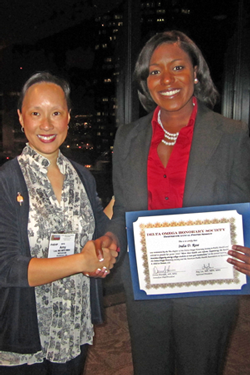Arnold School student one of only 19 to be selected for Delta Omega student poster session
November 18, 2010

Arnold School student India Rose, right, was
selected to present her research at the Delta
Omega student poster session at the recent
APHA meeting. Dr. Nancy Lee, the national
Delta Omega president, is shown with Rose.
(Editor’s Note: Articles will appear over the coming weeks about honors from APHA. Please share your stories via email to kpetit@mailbox.sc.edu.)
Arnold School doctoral student India Rose was one of only 19 students from throughout the United States to be selected by the Delta Omega Honor Society in Public Health to present her research at a poster session during the recent APHA meeting in Denver.
The 13th annual Student Poster Session through the American Public Health Caucus highlighted student research in academic interest areas such as bullying and victimization, low birthweight infants, seasonal and pandemic flu vaccinations of pregnant women and diet change in women after a breast cancer diagnosis.
Rose’s study was a collaborative research effort between the University of South Carolina’s Columbia and Sumter campuses.
“The purpose of this research was to examine the health insurance disparity among college students at two-year institutions and examine their healthcare seeking behaviors as related to the prevention of sexually transmitted infections (STI),” Rose said.
“The college-aged population not only has the highest prevalence of being uninsured, but this age group also has the highest incidence of STIs,” she said. “This research is significant because more than 46 million Americans are currently uninsured. This number includes more than 6 million college students.”
Rose’s study found that most (82 percent) four-year institutions provide students with mandatory health insurance plans. However, only 29 percent of two-year schools offer these plans to their students.
“The recently passed Healthcare Reform made efforts to include the college-age population by extending the age of coverage to 26,” she said. “However, college students at two-year institutions were still overlooked because the average student at two-year schools is 29.”
The results of the study have major implications for healthcare providers and also shows the need for health insurance plans at two-year institutions.
Among the findings:
- White students are more likely to have health insurance coverage than African-American students.
- White students are more likely to consult a private physician for their healthcare needs; African-American students are more likely to use a local health department.
- Students are more likely to seek healthcare services specific to STI testing if they have health insurance coverage.
“This study concludes that it will take more dedicated healthcare reform efforts toward the college population, particularly those at two-year institutions, to address the health insurance disparity among this population,” Rose said.
Supporting authors on the study were Winston Abara, doctoral student; Leah Williams, doctoral candidate, and Dr. Lucy Annang, PhD, associate professor, all from the Department of Health Promotion, Education, and Behavior; and Dr. Pearl Fernande of the Division of Science, Math, & Engineering, University of South Carolina, Sumter.



_01.jpg)